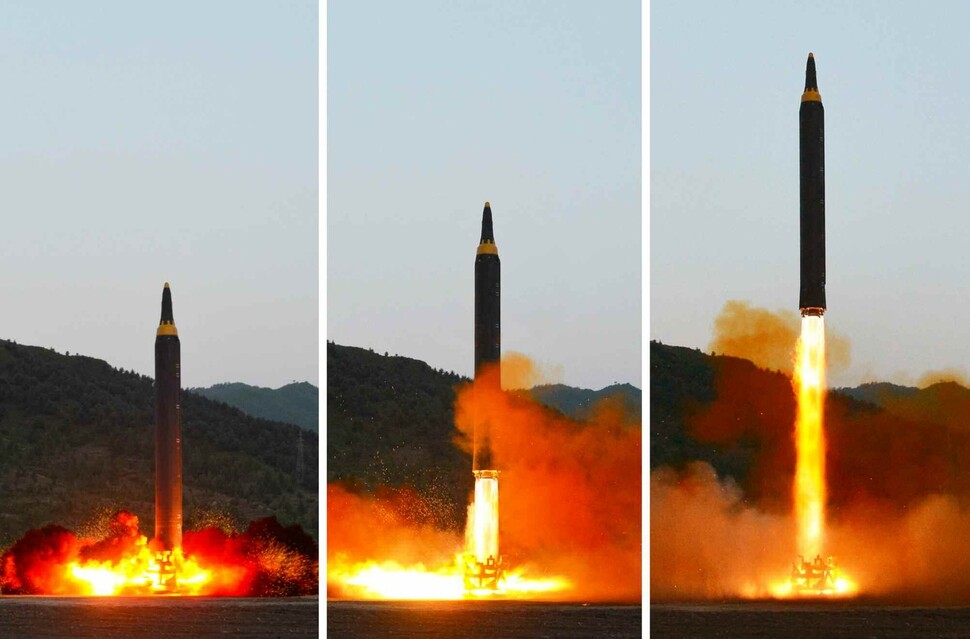hankyoreh
Links to other country sites 다른 나라 사이트 링크
Hwasong-12 a stepping stone in North Korea’s ICBM development

North Korea announced on May 15 that the missile it had launched the previous day was a newly developed Hwasong-12 intermediate-range ballistic missile. Analysts saw the Hwasong-12, which became the first North Korean missile to reach an altitude above 2,000 km, as a stepping stone in North Korea’s intercontinental ballistic missile (ICBM) development.
The Korean Central News Agency (KCNA), Rodong Sinmun, and other North Korean state media outlets reported on May 15 that scientists and engineers had successfully conducted a test launch the day before on the Hwasong-12, a “newly developed surface-to-surface intermediate-range strategic ballistic rocket.” The reports also showed images of the launch and photographs of leader Kim Jong-un conducting field guidance. According to North Korean reports, the missile was launched at 4:58 am (5:28 am Seoul time) and reached an altitude of 2,111.5 km before falling into the East Sea 787 km away.
North Korea has yet to provide any details on the missile‘s performance or characteristics. But its reports that the launch confirmed “the pressurization system and other technological aspects” have led analysts to conclude it was a liquid-propellant missile. A pressurization system is used to spray liquid fuel. The released images of the missile’s fuselage also suggest it was a single-stage rocket.

The Hwasong-12 is believed to have a new and different engine from the Scud or Musudan missiles. On Mar. 18, Pyongyang announced that it had succeeded in “ground jet testing for a new form of high-output engine,” which may have been used for the Hwasong-12.
In performance terms, the missile is believed to have surpassed the Musudan. The term intermediate-range ballistic missile (IRBM) typically refers to ballistic missiles with ranges between 3,000 and 5,500 km. North Korea also described the Musudan as an IRBM. But while the title of the Musudan was Hwasong-10, the latest missile was the Hwasong-12. Given North Korea’s practice of assigning sequential numbers to its missiles from short to long range, the latest missile is believed to have a range midway between the Musudan and the KN-08 (Hwasong-13) or KN-14 (Hwasong-14).

In a piece on the North Korea website 38 North on May 14, US missile expert John Schilling estimated the Hwasong-12 missile’s range at 4,500 km, longer than the Musudan‘s estimated range of 3,000 km. The range would put Guam - 3,400 km away - within the strike zone from Wonsan, although not Alaska (over 5,000 km away) or Hawaii (more than 7,000 km). But if the missile is successfully developed with a multi-stage rocket, its evolution to achieve strike capabilities against the continental US cannot be ruled out. North Korea claimed the missile could accommodate “not only a standardized warhead, but also a large heavy warhead” and said the test “confirmed the precision operation of the nuclear warhead detonation system.”
The UN Security Council plans to hold an emergency meeting on the afternoon of May 16. The meeting was reportedly called at the request of South Korea, the US, and Japan. The UNSC has released five press statements on North Korean ballistic missile launches this year.
In a May 14 appearance on the ABC program “This Week,” US ambassador to the United Nations Nikki Haley said the US was “going to continue, whether it’s [a resolution for] sanctions, whether it’s press statements [by the UNSC], anything that we have to do.”
“[T]here’s a lot of sanctions left that we can start to do, whether it’s with oil, whether it’s with energy,” Haley added.
When asked about the circumstances under which US President Donald Trump might meet with Kim Jong-un, Haley replied, “Having a missile test is not the way to sit down with the president.”
“[Kim] can sit there [with Trump] and say all the conditions he wants, [but] until he meets our conditions, we‘re not sitting down with him,” she continued.
By Yi Yong-in, Washington correspondent
Please direct questions or comments to [english@hani.co.kr]

Editorial・opinion
![[Column] Park Geun-hye déjà vu in Yoon Suk-yeol [Column] Park Geun-hye déjà vu in Yoon Suk-yeol](https://flexible.img.hani.co.kr/flexible/normal/500/300/imgdb/original/2024/0424/651713945113788.jpg) [Column] Park Geun-hye déjà vu in Yoon Suk-yeol
[Column] Park Geun-hye déjà vu in Yoon Suk-yeol![[Editorial] New weight of N. Korea’s nuclear threats makes dialogue all the more urgent [Editorial] New weight of N. Korea’s nuclear threats makes dialogue all the more urgent](https://flexible.img.hani.co.kr/flexible/normal/500/300/imgdb/original/2024/0424/7317139454662664.jpg) [Editorial] New weight of N. Korea’s nuclear threats makes dialogue all the more urgent
[Editorial] New weight of N. Korea’s nuclear threats makes dialogue all the more urgent- [Guest essay] The real reason Korea’s new right wants to dub Rhee a founding father
- [Column] ‘Choson’: Is it time we start referring to N. Korea in its own terms?
- [Editorial] Japan’s rewriting of history with Korea has gone too far
- [Column] The president’s questionable capacity for dialogue
- [Column] Are chaebol firms just pizza pies for families to divvy up as they please?
- [Column] Has Korea, too, crossed the Rubicon on China?
- [Correspondent’s column] In Japan’s alliance with US, echoes of its past alliances with UK
- [Editorial] Does Yoon think the Korean public is wrong?
Most viewed articles
- 1‘We must say no’: Seoul defense chief on Korean, USFK involvement in hypothetical Taiwan crisis
- 2N. Korean delegation’s trip to Iran shows how Pyongyang is leveraging ties with Moscow
- 346% of cases of violence against women in Korea perpetrated by intimate partner, study finds
- 4[Column] Park Geun-hye déjà vu in Yoon Suk-yeol
- 5‘Weddingflation’ breaks the bank for Korean couples-to-be
- 6Will NewJeans end up collateral damage in internal feud at K-pop juggernaut Hybe?
- 7Amnesty notes ‘erosion’ of freedom of expression in Korea in annual human rights report
- 8[Interview] Dear Korean men, It’s OK to admit you’re not always strong
- 9Korean government’s compromise plan for medical reform swiftly rejected by doctors
- 10[Editorial] Japan’s rewriting of history with Korea has gone too far